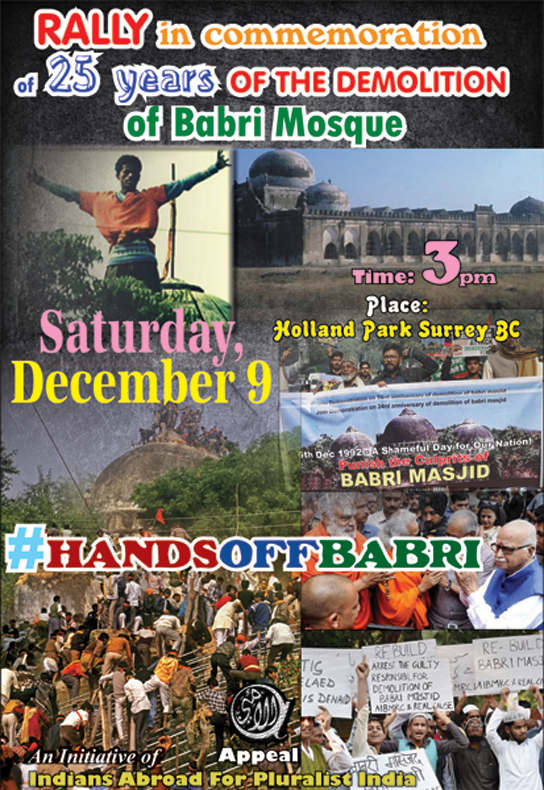
 Print
25 years of the demolition of Babri Mosque
11-28-2017
On Dec.22, 1949, local Hindu devotees in Ayodhya placed idols inside the Babri Masjid and claiming the mosque was built on the birthplace of Ram and converting the mosque into a Temple.
Built in 1527, the 490-year-old mosque was named after the first Mughal emperor of India. About 150,000 plus raging mob of Hindu activists gathered for a political rally that turned into a riot demolished the mosque.
In the aftermath, more than 2000 people were killed in communal riots across India and property damages of more the 90 Billion Indian Rupees resulted in Mumbai alone.
Prior to the demolition Bharatiya Janata Party and Vishwa Hindu Parishad campaigned that Babri Masjid was constructed by Mughal emperor Babur after destroying temples in its place and the mosque had to be erased.
BJP veteran L K Advani was leading the Ram Rath Yatra from Somnath in 1990. The yatra was provided support by then BJP-led Uttar Pradesh state government headed by Chief Minister Kalyan Singh. His government had allowed more than 150 thousand kar sevaks -(religious Hindu devotees) to erect tents around the site of Babri Masjid. The devotees from various Hindu right-wing outfits who had started converging at Ayodhya since 30th November 1992. Many people were recruited in Bajrang Dal and Durga Vahini with a sole aim of tearing down Babri Masjid and then building a Ram Mandir on the site.
Kalyan Singh's announcement that UP police will not fire a single bullet also somewhat encouraged the mob to demolish the mosque.
Ram Dutt Tripathi who was there when Babri Masjid was razed to the ground said, “The fact that BJP state government won't take any action against them, also played its role. Assurances like these made the mob fearless.”
“The crowd was so big that they broke the cordon and scaled the fence. As soon as they were inside, the demolition began. Many were there who wouldn’t have stopped even after firing. The demolition started after 12 PM and by 5 in the evening, all the three domes of Babri Masjid were razed to the ground.”
Krishna Jha and Dhirendra K. Jha examined what led to the events of the mosque demolition in their book “Ayodhya: The Dark Knight.”
In an interview with Krishna Pokharel for wall street Journal the Authors states that a sadhu, a Hindu holyman “whose action on the night of Dec. 22, 1949 has had such a long-lasting impact on the nation, its politics and society” till this day.
“The installation of the idol was a way of helping a group of sadhus, the Nirvani akhara, gain control over Ayodhya.”
Prior to Dec. 22, 1949 the platform that was considered the Janmabhoomi, or birthplace, of Lord Ram was located about fifty feet away from the mosque.
“Only after the idol was planted inside the mosque did the demand for converting Babri Masjid into a temple enter the legal and later the political arena” the authors said.
Dec.6, 1992 marks the day of the demolishing of the Mosque that had been there for centuries. It is also a day that has festered the India’s secular fabric ultimately dividing the nation on communal lines and the rise of Hindutva based politics.
“December 6th thus remains a reminder of how Hindu communalists sought to trample on the soul of the nation and how in the end the inherent strength of the nation’s composite culture won.”
Disputed Claims
The Uttar Pradesh Shia Waqf Board on Tuesday 08 August 2017 filed an affidavit in the Supreme Court saying a mosque can be built in a Muslim-dominated area maintaining a reasonable distance from Lord Ram's birth place in Ayodhya.
The Shia Waqf Board contended that the Sunni Waqf Board has no stake in the case since the mosque was a Shia property.
"Since Babri Masjid was a Shia Waqf, only Shia Central Waqf board, Uttar Pradesh, is entitled to negotiate and arrive at a peaceful settlement with other remaining stakeholders," the affidavit stated.

Footnotes:
|